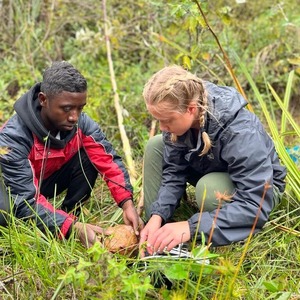
Development of Inexpensive and DIY Water Sensors to Advance Community-Led Nature-Based Conservation Solutions
Research Location:
Madagascar
Conservation Partners:
Conservation International Madagascar and Moore Center for Science
2025 Student Researchers
Mandy Joyce '26, Majors: Integrative Conservation and Environmental Science
Cy Strain-Seymour '26, Majors: Computer Science and Linguistics
Michaël Fenomanarivo, Université de Fianarantsoa (graduate) and CI ResearcherPast Student Researchers
Fiona Gordon '25, Major: Physics
Sophia Holincheck '24, Majors: Chemistry and Computer Science
Leo Eichers '25, Major: Chemistry; Minor: Geology
Jacob Timko '24, Major: Biology; Minor: Biochemistry
Faculty Mentors
Dr. Nathan Kidwell and Jonathan FreyProject Description
To effectively protect nature from the cascading impacts of climate change, local communities need support in designing, implementing, and evaluating potential solutions. Nature-based solutions (NBS) leverage sustainable planning, environmental management, and engineering practices to protect or restore natural ecosystem processes. These solutions are essential in promoting adaptation and resilience, especially in water management. However, for NBS to effectively support resilient water resources, local communities need efficient and accessible tools to monitor the impact of their conservation efforts.
Currently, monitoring community-led NBS is limited by the high costs and inaccessibility of scientific water monitoring tools. To overcome this challenge, there is a need for a low-cost, accessible water turbidity sensor that local communities can develop, maintain, and use to track the effects of NBS in protecting water resources against climate change.
Conservation International (CI)'s Priceless Planet Coalition Project supports Malagasy communities in restoring forest ecosystems to strengthen ecosystem services and enhance the local economy. Despite their success in advancing community-led forest restoration across the Lake Aloatra region of Madagascar, CI and local communities lack the necessary tools to monitor the impact of these landscape-scale restoration efforts on water ecosystems.
To address this gap, William & Mary and Malagasy students are collaborating with CI Madagascar staff, the Moore Center for Science, faculty from the W&M Chemistry Department and MakerSpace, and local communities around Lake Aloatra to develop a low-cost, accessible turbidity sensor that can be used to monitor restoration impacts.
In 2023, the team successfully built a turbidity sensor and traveled to Madagascar to test it in the freshwater streams near community-led restoration sites in Lake Aloatra. In 2024, the students incorporated lessons learned from local communities and field testing to refine and reduce the sensor’s cost. They also created a guide to help local communities build and use the sensor in Madagascar. In 2025, the team will continue improving the sensor’s efficacy and explore opportunities to scale its development and use for monitoring community-led restoration efforts throughout Madagascar.
Learn more here
A video of of the project, 2024 by Virginia Johnson















